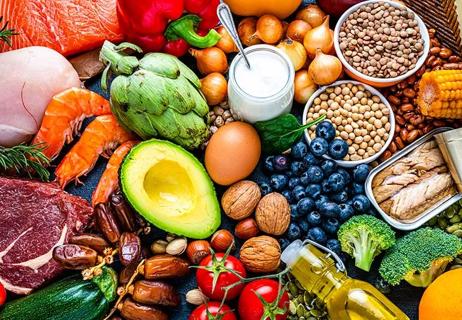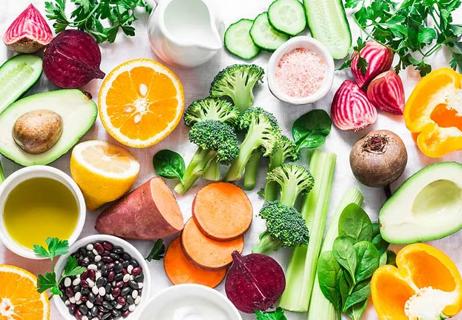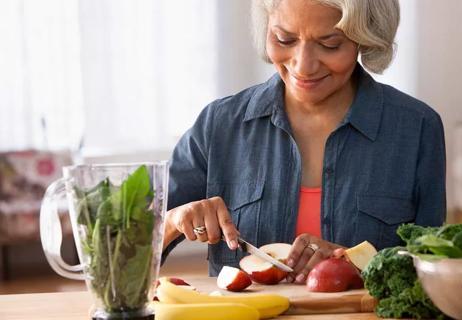Move over, oranges! You can also get vitamin C from strawberries, kiwi and green veggies

When you think of vitamin C, you may think primarily of oranges, but it’s actually abundant in lots of other foods — foods you’re probably already eating on a regular basis.
Advertisement
Cleveland Clinic is a non-profit academic medical center. Advertising on our site helps support our mission. We do not endorse non-Cleveland Clinic products or services. Policy
Vitamin C is especially plentiful in citrus fruits (oranges, yes, but also grapefruit, lemons, etc.) and vegetables (especially cruciferous vegetables, which we’ll explain in a moment).
Registered dietitian Devon Peart, RD, MHSc, shares more info about foods that are high in vitamin C, plus tasty tips for incorporating them into your diet.
Vitamin C is an essential nutrient, which means your body needs it but can’t make it on its own. Instead, you have to get vitamin C from the foods you eat — namely, fruits and vegetables.
“For peak freshness and nutrients, choose fruits and vegetables that are in season where you live,” Peart advises. “Frozen fruit and veggies are a great option, too, especially if you live in climates where seasonal produce is limited.”
But why do you need vitamin C in the first place? Good question. It helps your body form and maintain connective tissue like skin and bones, and it’s also a powerful antioxidant, protecting your cells from damage caused by harmful molecules known as free radicals.
Let’s start with what you already know: Yes, oranges are a great source of vitamin C. But they’re certainly not the only citrus fruits that deliver on this important nutrient.
Advertisement
The amount of vitamin C in citrus fruits varies depending on a lot of factors, including the type, size and ripeness of the fruit itself. But here are some estimates of the vitamin C content in common citrus fruits:
“Just one orange or grapefruit can fulfill your daily required dose of vitamin C,” Peart says.
How to enjoy them: Here’s a vitamin C-forward recipe you probably haven’t tried yet: Quinoa Orange and Pistachio Salad fulfills 100% of your daily requirement of vitamin C and vitamin A.
It’s not breaking news that green veggies are good for you, but you may be surprised to learn that they’re a great source of vitamin C, too. Vegetables in the cruciferous category all have distinctive, cross-shaped flowers — and many of them give you all or most of your daily vitamin C intake:
“These veggies are all nutrient-dense and antioxidant-rich,” Peart says. “They’re also known to have anti-inflammatory properties, which can help reduce the risk of chronic diseases like heart disease and arthritis.”
A word of caution: If you’ve been diagnosed with an underactive thyroid (hypothyroidism), check with your healthcare provider before eating (or juicing) a lot of cruciferous veggies, as they can interfere with your body’s production of thyroid hormone.
How to enjoy them: Bored by regular salads and snacking on raw veggies? Incorporate cruciferous vegetables into your diet with new-to-you recipes like:
If you’ve been told that this most consummate of carbs can’t be part of a healthy lifestyle, it’s time to rewrite the script.
One medium-sized russet potato (that’s the standard waxy, brown kind) has about 17 mg of vitamin C, or approximately 35% of your daily intake. They’re also a good source of potassium and vitamin B6.
How to enjoy them: It’s best to skip the French fries and tater tots. “The key to healthier potatoes is to not fry them in oil or top with lots of butter and salt,” Peart states. “You can boil or roast them or, if you’re craving that crispy crunch, try cooking them in the air fryer with a light coating of heart-healthy olive oil.”
There’s also always the classic baked potato (just add broccoli and cheese) or, for something a little unusual, try your hand at Walnut Zucchini Potato Pancakes.
Advertisement
Peppers are kind of like the opposite of traffic lights. When it comes to this crunchy garden veggie, red means go: Red bell peppers have 1.5 times more vitamin C than their green counterparts.
“A medium red pepper has more than 150% of your daily recommended vitamin C intake,” Peart confirms.
How to enjoy them: Red peppers make for a simple snack. Just core and deseed one, then cut it into strips and enjoy it with hummus, muhammara or cannellini bean dip. You can also roast red peppers to eat as a side or to add to salads and sandwiches. And sautéed red peppers are perfect atop pizza and pasta or added to omelets and or stir-fries.
One cup of strawberries has almost 150% of your daily recommended intake of vitamin C. They’re also a good source of dietary fiber, folate and antioxidants, making them a great addition to your diet overall.
“Strawberries are a smoothie staple and a fantastic summer snack,” Peart says. “They’re also a good base for decadent desserts that won’t send your blood sugar skyrocketing.”
How to enjoy them: For a new spin on this timeless fruit, try Strawberry Pretzel Squares or Vanilla Panna Cotta with Strawberries and Mint.
Also known as pawpaw, the papaya is a soft, buttery fruit that kind of tastes like a mango merged with a cantaloupe. And although it seems like it must be a melon, it’s actually a very large berry!
Advertisement
One cup of fresh papaya has nearly 90% of your daily recommended intake of vitamin C. “It’s also packed with dietary fiber, folate and vitamin A,” Peart says.
How to enjoy it: Transport your taste buds to the tropics by eating fresh papaya on its own or add it to Greek yogurt.
Guava is a vitamin C overachiever: One fresh guava is packed with anywhere from 73 mg to 247 mg of it, depending on the variety. Most guavas will give you about 200% of your daily recommended vitamin C intake.
How to enjoy it: Not sure what to do with this flavorful tropical fruit? “Like any fruit, you can eat it on its own,” Peart suggests. “Just wash it, cut it in half, and use a spoon to scoop out the soft, juicy flesh inside. You can also add it to fruit salad or smoothies.”
Some people think of cantaloupe as a “filler fruit,” but what it really fills you up on is nutrients, including vitamins C and A, potassium and fiber. “One cup of diced cantaloupe, whether in a fruit salad or on its own, will give you about 58% of your daily recommended amount of vitamin C,” Peart notes.
How to enjoy it: For two great sources of vitamin C in one tasty side dish, whip up a Cantaloupe and Tomato Salad — they work great together, we swear! Jalapenos, lime juice and pumpkin seeds add acidity, heat and a little bit of crunch, all with very few calories and quite a few nutrients.
Advertisement
Your favorite garden veggie (errr, fruit) gives you about 17 mg of vitamin C, although the amount in each tomato depends on its size, variety and other factors. That’s about 28% of your daily recommended intake, not to mention other nutrients like potassium, folate and vitamin K.
How to enjoy them: You probably already have a few favorite ways to prepare tomatoes, but their versatility makes them a nearly endless source of kitchen creativity. For a quick, easy and delicious option, try this Four-Ingredient Tomato Sauce, which jazzes up plain pasta without all the sugar and preservatives of canned sauce.
Want to knock out all your daily vitamin C in one little fruit? Go green! “Have one kiwi at breakfast, and you’ll have consumed about 117% of your recommended daily amount of vitamin C,” Peart says.
Kiwi boasts other health benefits, too, including fiber, vitamin E and potassium — and you’ll get even more of those benefits if you eat it with the skin on.
How to enjoy it: For a departure from your standard smoothie, try making a Creamy Kiwi-Lime Smoothie that packs a high-protein punch. You’ll be all set on vitamin C for the day.
You don’t have to chow down on a stalk of kale or chug a glass of orange juice to get your vitamin C fix. Peart shares more easy tips for getting your daily dose of this vitamin in tasty, easy-to-prepare ways:
“Orange” you glad you know all of these ways to load up on vitamin C? Your body will thank you for it — and your taste buds aren’t likely to complain either.
Learn more about our editorial process.
Advertisement

Vitamin C and B-complex vitamins pass quickly through your body, so eat them often

From healing wounds to boosting your immune system, this is one multifaceted vitamin

Not only can it strengthen your immune system, but vitamin C can do a whole lot more, too

This popular ingredient isn’t just for citrus fruits anymore

Eat your fill of vitamins C, B6 and E, plus zinc and selenium

Instead of relying on supplements, choose foods that boost your immune system

There are several vitamins and mineral supplements that many people can benefit from — but it’s important to consult with a healthcare provider before you start one

When it comes to getting proper nutrition, your assigned sex can play a role — but there’s more to it than that

Type 2 diabetes isn’t inevitable with these dietary changes

Applying a hot or cold compress can help with pain